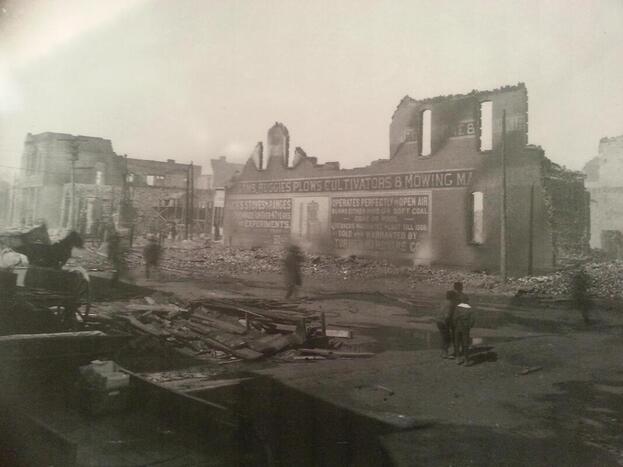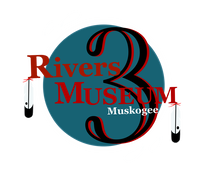Muskogee's Great Fire of 1899
THE TRUE SPIRIT of Muskogee pioneers was displayed during and after many fires that erupted in Muskogee before the turn of the century. These tragic fires tested the courage and fortitude of the men and women of this growing city. After each of these fires, the residents worked together to build back their homes, businesses, and community “bigger and better than before.” Their strength and ambition laid an important foundation for what Muskogee is today.
The largest and most destructive of these fires occurred on February 23, 1899. According to most historical accounts, the fire started about 5 a.m. at P.R. Caesar's Tailoring and Cleaning Plant on the east side of Second Street between Court and Broadway. Stories of the time indicate that a worker at the plant poured kerosene over coals to build a fire. This caused an immediate explosion and a roaring blaze soon engulfed the building.
Within moments someone began shooting their firearm into the air as a warning. Train whistles soon "bellowed out" trying to alarm the sleeping residents of the danger that was at hand. It was not long before citizens ran to the street to see what was happening. They were greeted by the sight of roaring flames and thick, black smoke.
The fire department soon arrived at the scene and began the unenviable task of fighting the blaze. The department at that time was strictly a volunteer organization with minimal equipment and training. The firemen were led by Chief Charles Seeking who was the owner and operator of a grocery store on Baltimore Avenue.
A hose cart was eventually hauled to the fire site, however, by that time, the flames were roaring into the air with strong gusty winds fanning the flames. Water was obtained by the firemen from the KATY pond (near the present day site of Arrowhead Mall). Historical accounts indicate that the firemen pointed a hose at the fire "out of which trickled a stream of water that fell three yards away from the firemen or else was blown back in their faces by the strong wind." Additionally, temperatures on that winter morning were near zero, making it an almost intolerable ordeal for these brave men.
The fire spread east towards Main Street and soon the Maddin Hardware Company building (present day site of Royal Casket Company) became a victim of the flames. The fire then turned south down Main Street destroying almost all property in its path. The Turner Hardware Company was laid to ruins and soon the beautiful Hotel Adams, the pride of Indian Territory, was turned to ashes. One by one the buildings went down. The English Block, the Turner Opera House, the KATY Passenger Depot, and others were all destroyed.>
The Muskogee Phoenix later reported “the fire department did everything possible with its limited apparatus and helped to hold the fire in bounds. There were so many deeds of heroism that it would be impossible to enumerate them." The fire was eventually held in check by the brick walls of the Patterson Mercantile Company and the First National Bank building on the south corners of Broadway and Main. The U.S. Court building was saved by "the most heroic of work as several times the front rooms were a roaring furnace.”
Miraculously, there were no reports of deaths mentioned in historical accounts of the fire. The most seriously injured were the firemen who were "given whiskey without regard to where it was obtained, in order to keep them in condition to fight the blaze." One of the firemen, John Leiber did require serious medical attention as he was severely burned and scalded upon his face.
The Muskogee City Council minutes of February 27, 1899, reveal that a sinister crime may have also taken place during the tragedy. Councilman A.W. Robb reported at the meeting that "some of the fire hose was cut during the fire by unknown parties." Mayor Patrick Byrne later offered a resolution during the meeting that a $100 reward be put forth by the council for any information that led to the "arrest and conviction of the person or persons who cut the fire hose during the conflagration." There is no evidence that this person or persons were ever apprehended. The building and personal property losses were devastating to the community.
“Brick, stone, scrap iron, smoldering embers are all that remain of the splendid stores, shops, hotels, opera house, and offices of yesterday," the paper reported. Many of the persons affected by the damage had no insurance of any kind. The largest individual loss was that of C.W. Turner who had an estimated loss of $200,000. Other large losses included the Hotel Adams, the Maddin Hardware Company, and the Times Publishing Company. Total losses at the time were estimated at near one million dollars.
After the fire, members of the community gathered at the Sondheimer Hide Plant on Second and Okmulgee Street to discuss the disaster. In the midst of hysterical cries of the affected and the cold, biting temperatures, the assembled citizens began to talk about the future of their city. The voice of pioneer merchant C.W. Turner rose above the crowd. "I've made it before and can do it again.”
Another rough-handed workman was in the gathering and ran his hand down his torn and dirty clothing and said, "This is all." And then he held up his vigorous muscles and proclaimed, "I can make some more." Like the Phoenix bird, they intended that their city "would rise from the ashes" once again. They would not let another disaster spoil their plans of creating the most progressive city in the Indian Territory.
by Roger L. Bell
For further information see the following in the Grant Foreman Room of the Muskogee Public Library: Muskogee, I.T.: Queen City of the Southwest by C.W. “Dub” West“Muskogee’s Great Fire,” Twin Territories Magazine, March 1899; Muskogee City and County by Odie B. Faulk, 1982
The largest and most destructive of these fires occurred on February 23, 1899. According to most historical accounts, the fire started about 5 a.m. at P.R. Caesar's Tailoring and Cleaning Plant on the east side of Second Street between Court and Broadway. Stories of the time indicate that a worker at the plant poured kerosene over coals to build a fire. This caused an immediate explosion and a roaring blaze soon engulfed the building.
Within moments someone began shooting their firearm into the air as a warning. Train whistles soon "bellowed out" trying to alarm the sleeping residents of the danger that was at hand. It was not long before citizens ran to the street to see what was happening. They were greeted by the sight of roaring flames and thick, black smoke.
The fire department soon arrived at the scene and began the unenviable task of fighting the blaze. The department at that time was strictly a volunteer organization with minimal equipment and training. The firemen were led by Chief Charles Seeking who was the owner and operator of a grocery store on Baltimore Avenue.
A hose cart was eventually hauled to the fire site, however, by that time, the flames were roaring into the air with strong gusty winds fanning the flames. Water was obtained by the firemen from the KATY pond (near the present day site of Arrowhead Mall). Historical accounts indicate that the firemen pointed a hose at the fire "out of which trickled a stream of water that fell three yards away from the firemen or else was blown back in their faces by the strong wind." Additionally, temperatures on that winter morning were near zero, making it an almost intolerable ordeal for these brave men.
The fire spread east towards Main Street and soon the Maddin Hardware Company building (present day site of Royal Casket Company) became a victim of the flames. The fire then turned south down Main Street destroying almost all property in its path. The Turner Hardware Company was laid to ruins and soon the beautiful Hotel Adams, the pride of Indian Territory, was turned to ashes. One by one the buildings went down. The English Block, the Turner Opera House, the KATY Passenger Depot, and others were all destroyed.>
The Muskogee Phoenix later reported “the fire department did everything possible with its limited apparatus and helped to hold the fire in bounds. There were so many deeds of heroism that it would be impossible to enumerate them." The fire was eventually held in check by the brick walls of the Patterson Mercantile Company and the First National Bank building on the south corners of Broadway and Main. The U.S. Court building was saved by "the most heroic of work as several times the front rooms were a roaring furnace.”
Miraculously, there were no reports of deaths mentioned in historical accounts of the fire. The most seriously injured were the firemen who were "given whiskey without regard to where it was obtained, in order to keep them in condition to fight the blaze." One of the firemen, John Leiber did require serious medical attention as he was severely burned and scalded upon his face.
The Muskogee City Council minutes of February 27, 1899, reveal that a sinister crime may have also taken place during the tragedy. Councilman A.W. Robb reported at the meeting that "some of the fire hose was cut during the fire by unknown parties." Mayor Patrick Byrne later offered a resolution during the meeting that a $100 reward be put forth by the council for any information that led to the "arrest and conviction of the person or persons who cut the fire hose during the conflagration." There is no evidence that this person or persons were ever apprehended. The building and personal property losses were devastating to the community.
“Brick, stone, scrap iron, smoldering embers are all that remain of the splendid stores, shops, hotels, opera house, and offices of yesterday," the paper reported. Many of the persons affected by the damage had no insurance of any kind. The largest individual loss was that of C.W. Turner who had an estimated loss of $200,000. Other large losses included the Hotel Adams, the Maddin Hardware Company, and the Times Publishing Company. Total losses at the time were estimated at near one million dollars.
After the fire, members of the community gathered at the Sondheimer Hide Plant on Second and Okmulgee Street to discuss the disaster. In the midst of hysterical cries of the affected and the cold, biting temperatures, the assembled citizens began to talk about the future of their city. The voice of pioneer merchant C.W. Turner rose above the crowd. "I've made it before and can do it again.”
Another rough-handed workman was in the gathering and ran his hand down his torn and dirty clothing and said, "This is all." And then he held up his vigorous muscles and proclaimed, "I can make some more." Like the Phoenix bird, they intended that their city "would rise from the ashes" once again. They would not let another disaster spoil their plans of creating the most progressive city in the Indian Territory.
by Roger L. Bell
For further information see the following in the Grant Foreman Room of the Muskogee Public Library: Muskogee, I.T.: Queen City of the Southwest by C.W. “Dub” West“Muskogee’s Great Fire,” Twin Territories Magazine, March 1899; Muskogee City and County by Odie B. Faulk, 1982
Muskogee's Regional Heritage CenterWith Assistance from the City of Muskogee
(c) 2024 Three Rivers Museum
|
FInd-Contact-connectMuseum Hours Facebook
Wednesday-Saturday 10 a.m.-5 p.m. Newsletter/Mailing List Contact Info 220 Elgin Muskogee, OK 74401 918-686-6624 [email protected] |

